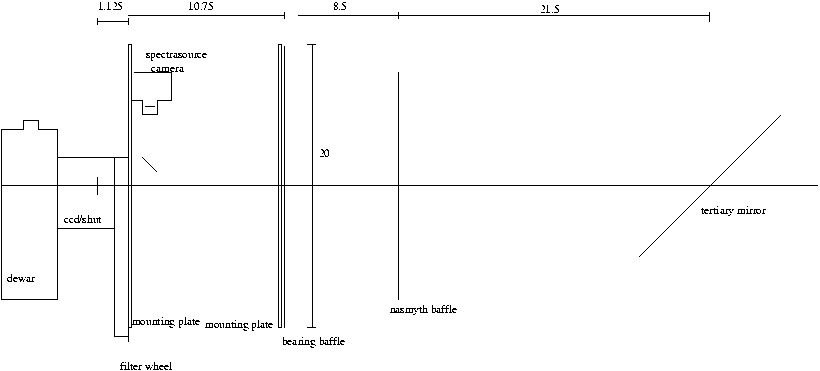Subsections
We had a new guider and filter wheel built by
Astronomical Consultants and Equipment
(Peter Mack) out of Tucson. This was installed
in mid-1999.
The idea was to make a much thinner filter
wheel which will allow the guider to be located much closer to the
focal plane. This allows the guider to come closer on-axis without
vignetting the primary beam to the science instrument. This is motivated
so we can maximize the size of baffles in the system to minimize scattered
light, which currently poses a problem.
The new guider consists of a guide box which is 9.25 inches thick,
followed by a thin (1.313 inch) filter wheel, followed by the CCD.
The guider module plugs into the side of the guider box, and uses our
SpectraSource CCD. The guide module has a pickoff mirror to direct light
to the guide camera. The entire pickoff/camera assembly is on a radial
stage; in addition, the pickoff mirror is on a separate stage to allow
focus control.
 Old design had a spacer box mounted on rotator mount, which has a
back mounting plate 5.25" behing the rotator mount. An off-axis guider
camera is located inside this box, mounted to the back plate. This
mount holds a 1.25" diagonal mirror along with a SpectraSource 512x512
CCD camera with 20 micron pixels. The center of the guider is currently
located
Old design had a spacer box mounted on rotator mount, which has a
back mounting plate 5.25" behing the rotator mount. An off-axis guider
camera is located inside this box, mounted to the back plate. This
mount holds a 1.25" diagonal mirror along with a SpectraSource 512x512
CCD camera with 20 micron pixels. The center of the guider is currently
located  2300 arcseconds off axis. However, at the current time,
the diagonal mirror housing partially vignettes the beam going to the
science instrument. There is currently no corrector in front of the
guider.
2300 arcseconds off axis. However, at the current time,
the diagonal mirror housing partially vignettes the beam going to the
science instrument. There is currently no corrector in front of the
guider.
Behind the spacer, a filter wheel is mounted. The current filter wheel
is 3.5" thick. It accomodates 6 2" square filters.
Behind the filter wheel, the science CCD camera is located. It has a
focal plane which is located 1.25 " (optical distance) behind the
mounting surface. The science CCD is 1024x1024 array put together
by Princeton Instruments. The CCD pixels are 24 microns square.
The old design placed the CCD array about 2 inches closer to the
secondary than is suggested by ray-tracing using the nominal optical
parameters.
We are currently operating using an APOGEE AP7p camera as the science
imager. This has a 512x512 thinned backside illuminated SITe chip with
24 pixels
in it. It is a thermoelectrically cooled camera which can operate about
50 degrees below ambient, leading to operating temperatures between
-50 and -30 C, depending on the season. Dark current is significant
at the warmer temperatures.
pixels
in it. It is a thermoelectrically cooled camera which can operate about
50 degrees below ambient, leading to operating temperatures between
-50 and -30 C, depending on the season. Dark current is significant
at the warmer temperatures.
We have a Princeton Instruments CCD camera which has a 1024x1024
SITe array with 24 pixels. This is a liquid nitrogen cooled
system. We had a commandable fill system built for this dewar by
VBS industries (see systems documentation).
pixels. This is a liquid nitrogen cooled
system. We had a commandable fill system built for this dewar by
VBS industries (see systems documentation).
The PI camera was purchased in the early 1990s. We have had a fair
amount of trouble with low level noise in the camera, and it has
been sent back to the manufacturer several times. Princeton Instruments
has been taken over by Roper Scientific.
2010-04-12
 Old design had a spacer box mounted on rotator mount, which has a
back mounting plate 5.25" behing the rotator mount. An off-axis guider
camera is located inside this box, mounted to the back plate. This
mount holds a 1.25" diagonal mirror along with a SpectraSource 512x512
CCD camera with 20 micron pixels. The center of the guider is currently
located
Old design had a spacer box mounted on rotator mount, which has a
back mounting plate 5.25" behing the rotator mount. An off-axis guider
camera is located inside this box, mounted to the back plate. This
mount holds a 1.25" diagonal mirror along with a SpectraSource 512x512
CCD camera with 20 micron pixels. The center of the guider is currently
located